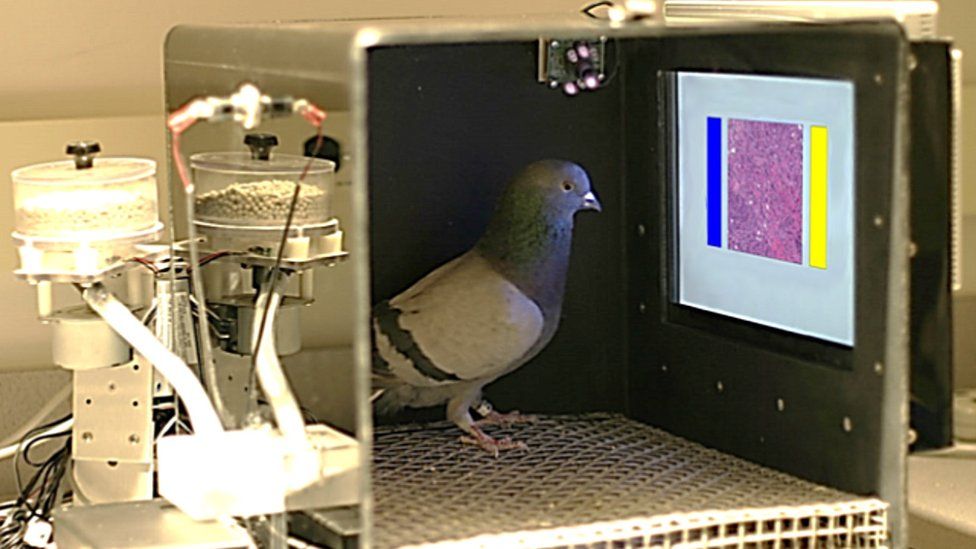Pigeons identify breast cancer 'as well as humans'
- Published

Pigeons, with training, did just as well as humans in a study testing their ability to distinguish cancerous from healthy breast tissue samples.
The pigeons were able to generalise what they learned, correctly spotting tumours in unseen microscope images.
They also did well at a particular mammogram-classifying task, though a second mammogram test (recognising suspicious lumps) proved too tricky.
The pigeons' ability could help improve new image-based diagnosis technologies.
It is described in the open access journal Plos One.
Bird brain
Likely no bigger than the tip of your index finger, the pigeon's brain nonetheless has impressive capabilities.
"Pigeons can distinguish identities and emotional expressions on human faces, letters of the alphabet, misshapen pharmaceutical capsules, and even paintings by Monet vs Picasso," said Prof Edward Wasserman from the University of Iowa, a co-author of the study.
"Their visual memory capacity is equally impressive, with a proven recall of more than 1,800 images."
Given these abilities, scientists started wondering how well pigeons would do at pathology tests.
Each bird was taught to distinguish microscope images of cancerous and non-cancerous tissue, by being rewarded only when a correct answer was provided.
The birds learned to recognise tumours at a range of magnifications and image compression levels, as well as in the absence of colour.
After two weeks of training, the pigeons reached a level of 85% accuracy. Because they successfully identified cancerous tissue from images they had not seen before, the researchers ruled out rote-learning of the images as an explanation.
"The birds were remarkably adept at discriminating between benign and malignant breast cancer slides," said lead author Prof Richard Levenson, from the University of California, Davis.
The researchers also tried a "flock-sourcing" approach. This involved pooling the decisions from a group of four birds, and led to an impressive 99% accuracy in diagnosis.
Improving imaging
As well as microscope slides, the birds were also tested for their diagnostic ability on images from mammograms. Here, they did well when asked to spot "microcalcifications": small deposits that can suggest a pre-cancerous growth.
However, when the team put the pigeons to work classifying suspicious masses - an important but difficult job for clinicians themselves - they were unable to recognise the lumps with malignant potential.
"As this task reflects the difficulty even humans have, it indicates how pigeons may be faithful mimics of the strengths and weaknesses of humans in viewing medical images," Prof Levenson said.
Other seemingly outlandish diagnosticians have included dogs sniffing out various types of cancer, and giant African pouched rats detecting tuberculosis. "We are not (yet) proposing such a role for pigeons," the authors write.
But the birds might be able to assist researchers and engineers in developing imaging-based cancer diagnostic tools.
Such tools have to be validated by trained clinicians, to ensure quality and reliability. This is a tedious and expensive process - which the common pigeon may be able to help with in the future.
- Published4 June 2015
- Published8 March 2015
- Published9 March 2014
- Published13 September 2012